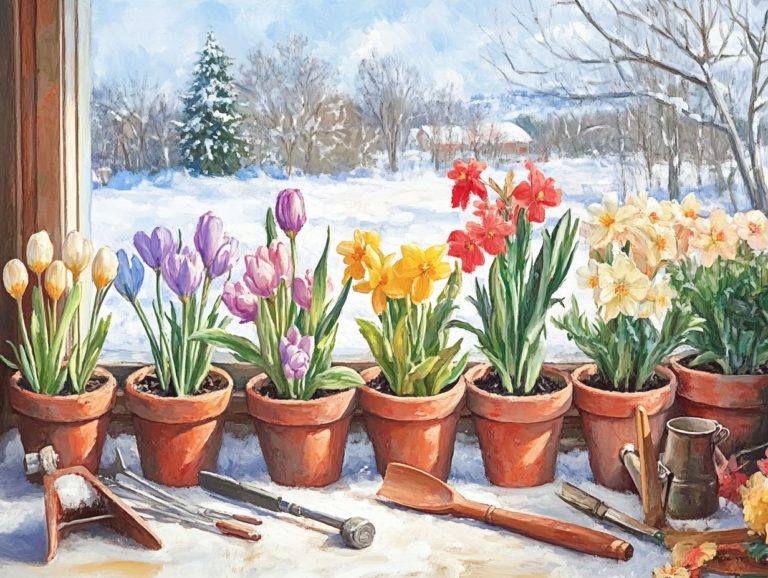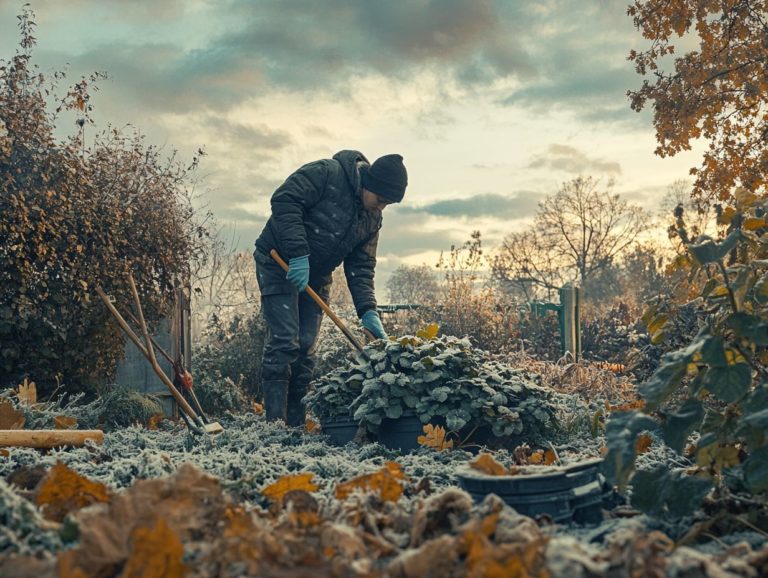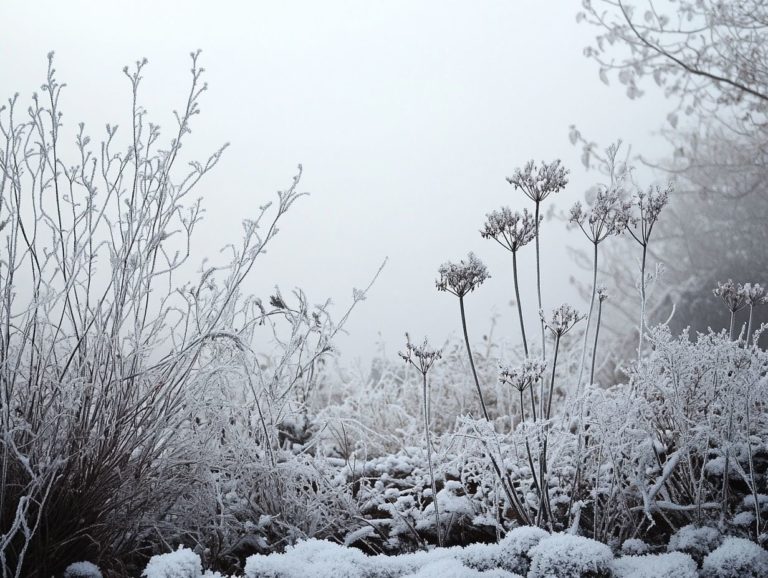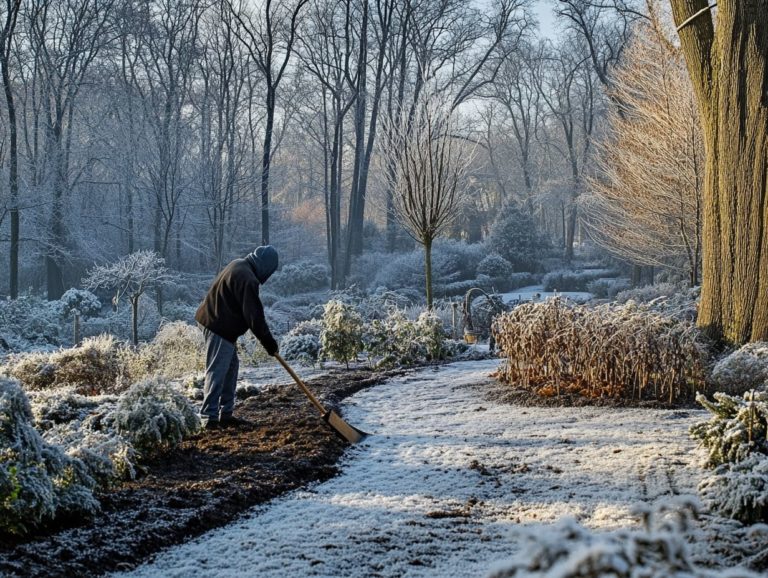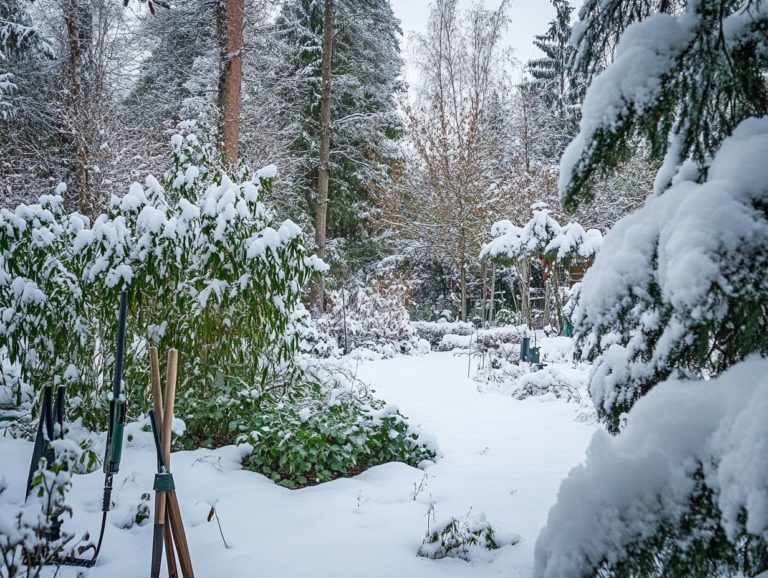5 Tips for Successful Winter Sowing
Winter sowing offers a remarkable opportunity to gain an early advantage in your gardening endeavors, even when the chill of winter lingers. This method aligns perfectly with sustainable gardening practices.
By adopting this technique, you can cultivate a healthy garden without the typical challenges associated with indoor seed starting. Here are five essential gardening tips designed to set you up for success, from selecting the right seeds to meticulously preparing your soil.
Discover the many benefits of winter sowing, the ideal conditions your plants need, and the common pitfalls to avoid. Pay special attention to maintaining proper moisture levels and ensuring adequate sunlight exposure.
Are you excited to dive into winter gardening? Let s embark on this journey together, sharing tips on container gardening and seed stratification along the way!
Contents
- Key Takeaways:
- 1. Start with the Right Seeds
- 2. Use the Right Containers
- 3. Prepare the Soil Properly
- 4. Monitor Moisture Levels
- 5. Protect Seedlings from Extreme Temperatures
- What Is Winter Sowing and How Does It Work?
- Frequently Asked Questions
- 1. What is winter sowing and why is it beneficial for gardening?
- 2. What are the key factors to consider when choosing seeds for winter sowing?
- 3. How should I prepare my containers for winter sowing?
- 4. Is it necessary to keep my winter sown containers outside during the entire winter?
- 5. How do I know when to move my winter sown seedlings to their permanent location?
- 6. Can I use winter sowing for all types of plants?
Key Takeaways:
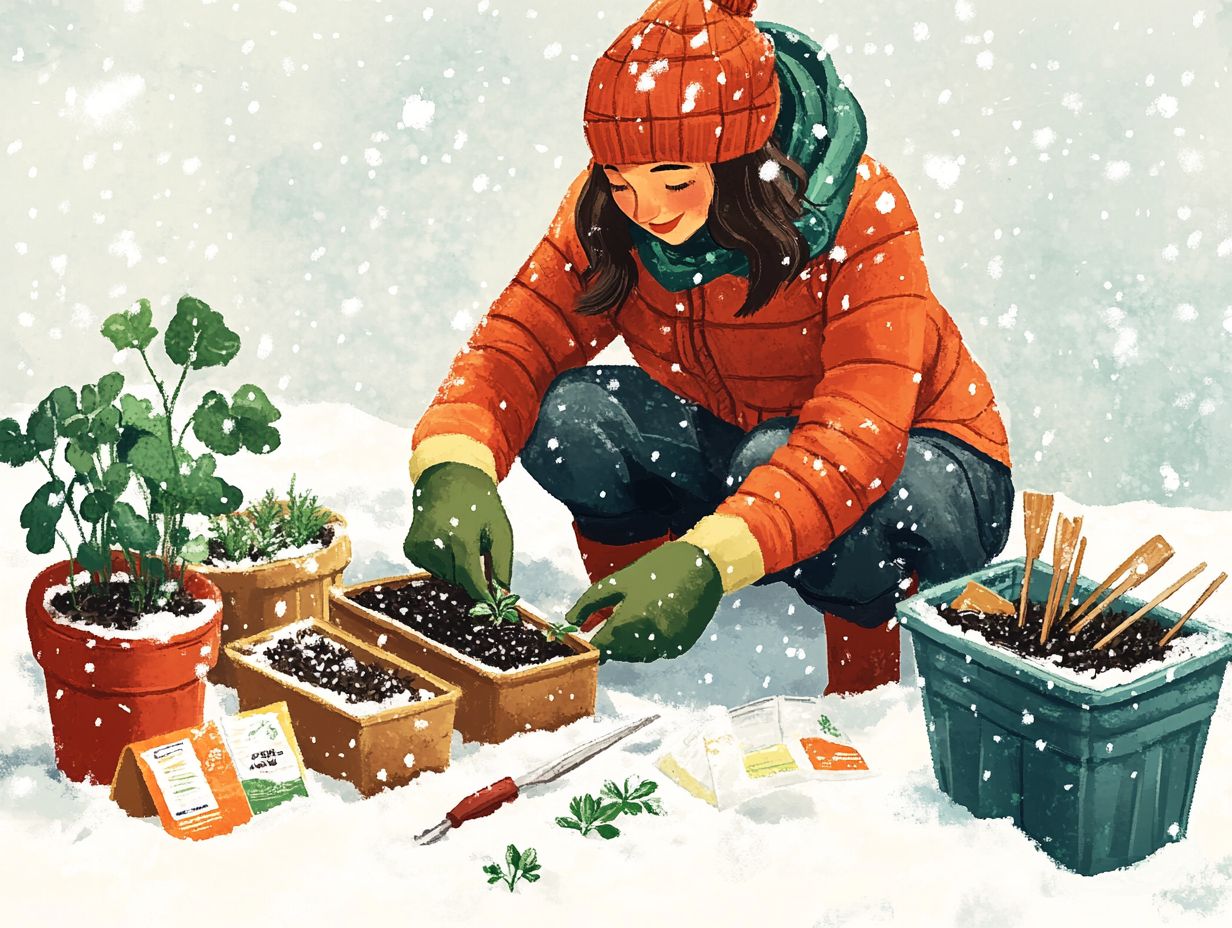
- Choose cold-hardy seeds for successful winter sowing, including vegetable seeds like kale and spinach.
- Use containers like milk jugs with good drainage and ventilation to avoid seed rot.
- Ensure the soil is fertile and well-drained for optimal seed growth, especially when growing herbs or annual plants.
1. Start with the Right Seeds
Beginning your gardening journey with the right seeds is vital for successful winter sowing, especially when considering the top 5 challenges in winter gardening. This sets a solid foundation for thriving plants and a vibrant garden landscape.
When you prioritize seed selection, particularly heirloom varieties such as tomatoes, you unlock unique flavors and resilience against pests and diseases. Choosing seeds adapted to your local climate significantly boosts their chances of success, as these plants are better equipped to handle regional temperature fluctuations and soil variations.
For winter sowing, consider incorporating varieties like kale, spinach, and Swiss chard. These are renowned for their cold hardiness and ability to germinate even amidst frost. The right seed choices enhance fertility and yield while fostering a sustainable gardening approach, including techniques like seed stratification, allowing you to enjoy the harmonious relationship between nature and cultivation.
2. Use the Right Containers
Utilizing the right containers can greatly enhance your winter sowing efforts. Transform everyday items like milk jugs into effective seed-starting vessels that create a nurturing environment for your plants, much like a DIY greenhouse. For more specialized advice, check out these tips for sustainable winter gardening.
These sturdy jugs can withstand harsh winter conditions. They also let natural sunlight reach the seeds, ensuring proper exposure for sprouted seeds. A simple cut through the jugs creates a mini greenhouse effect, effectively maintaining warmth and humidity.
Incorporating drainage holes is crucial. They help manage moisture and prevent root rot by allowing excess water to escape, creating conditions for healthy sprouted seeds. By positioning these containers correctly, you optimize growth while providing ample protection from freezing temperatures and snow, ensuring your seedlings have the best chance to thrive come spring.
In conclusion, winter sowing allows you to get a head start on your garden while promoting sustainable practices. Start your winter sowing journey today and reap the benefits!
3. Prepare the Soil Properly
Preparing the soil properly is an essential step in winter sowing. It ensures optimal conditions for seed germination and can help you implement 5 winter planting strategies for gardeners that support sustainable gardening practices, providing significant environmental benefits.
Maintaining adequately moist soil is crucial. It encourages healthy root development and prevents seed desiccation, especially during the transplanting time. You might want to consider seed stratification, a method to help seeds germinate by mimicking natural conditions. This is essential for seeds like onions and beets, allowing them to break dormancy more effectively.
Understanding the intricate balance of nutrients in your soil plays a vital role in enhancing plant growth and vitality, particularly for those growing herbs and vegetables. By dedicating time to soil health, you re not just fostering bountiful harvests; you re also nurturing the ecosystem, making your gardening efforts more environmentally conscious.
This foundational approach leads to strong, healthy plants that can thrive in diverse conditions, ultimately contributing positively to biodiversity and supporting vital populations of pollinators.
4. Monitor Moisture Levels
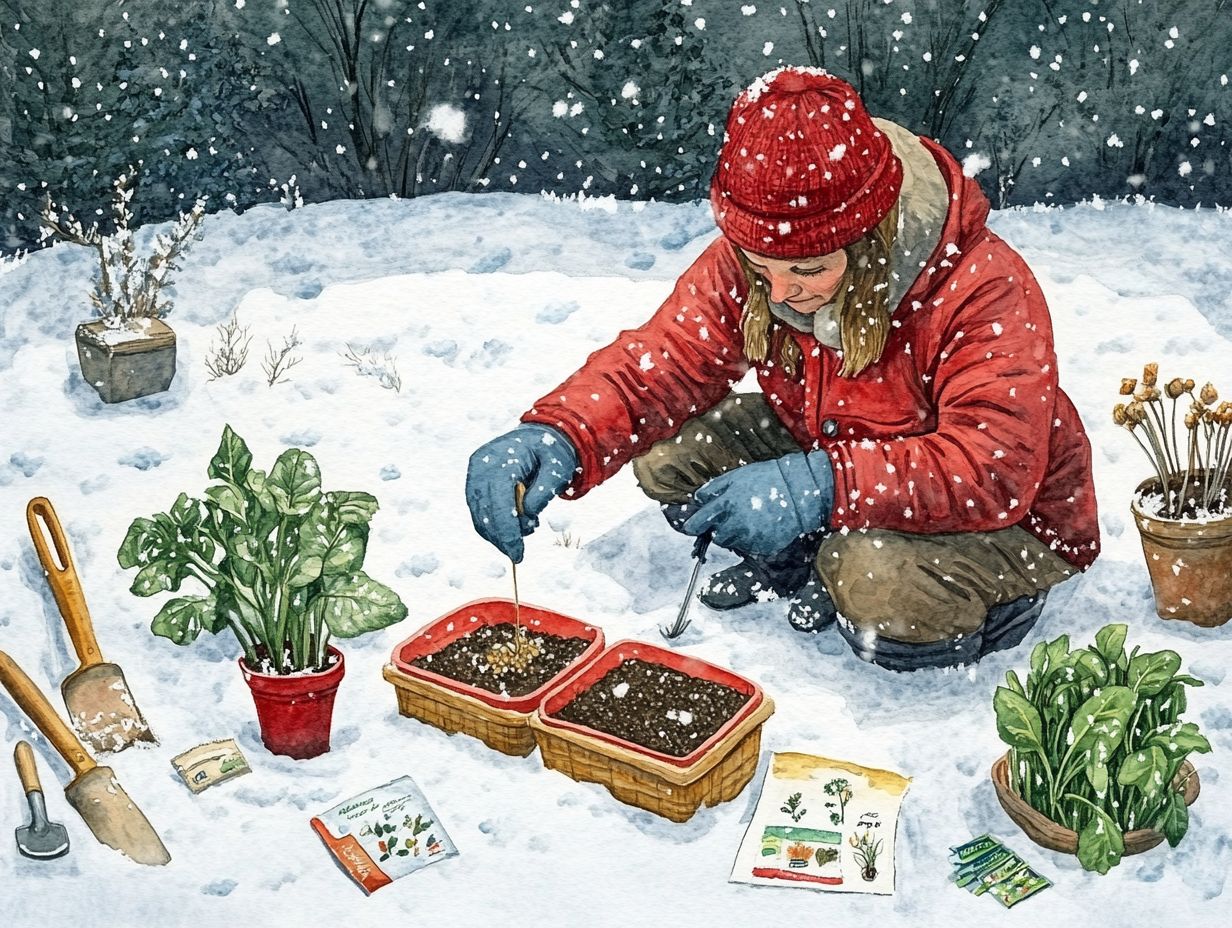
Monitoring moisture levels during winter sowing is essential! Consistent moisture nurtures healthy sprouted seeds and ensures they re primed for the perfect time to transplant into your garden beds or containers.
By paying close attention to moisture, you help your plants develop strong root systems. Maintaining moist soil is crucial for their thriving once they re moved outdoors. Without sufficient moisture, your seedlings can become stressed, stunting their growth potential and heightening the risk of transplant shock, which is the stress plants experience when moved to a new environment.
Using straightforward methods like a moisture meter or a simple finger test can provide you with valuable insights into your soil conditions. This ensures the right moisture levels for sprouted seeds. Grasping the nuances of transitioning from seed starting to transplanting will elevate your gardening skills! Effective moisture management is key to nurturing seedlings into strong, adaptable plants ready for their new environment.
5. Protect Seedlings from Extreme Temperatures
Protecting seedlings from extreme temperatures is essential for their survival and growth. This is especially important during the unpredictable chill of winter. Ensure they receive adequate natural sunlight while keeping them safe from harsh elements!
To strike this delicate balance, you can employ various techniques tailored to the needs of your young plants. Using protective covers can create a microclimate that shields seedlings from frost while still allowing sunlight to filter through. Relocating your seedlings to a more sheltered spot during particularly harsh nights can prevent them from succumbing to freezing temperatures.
It s important to keep a close eye on weather conditions, especially cold weather. Sudden changes can pose significant risks to your seedlings. By thoughtfully adjusting their surroundings, you can cultivate a nurturing environment that promotes healthy development and resilience in your seedlings. This maximizes their growth potential as they prepare for transplanting time!
What Is Winter Sowing and How Does It Work?
Winter sowing is a remarkable gardening technique that allows you to start seeds outdoors during the chilly winter months. By using containers to start seeds effectively, you harness the natural cold stratification process. This enhances seed germination and benefits the environment through reduced energy use.
This method has roots in traditional practices. Savvy gardeners discovered how to use the elements to give their seedlings an early advantage. They often shared their techniques on platforms like Instagram. By placing seeds in containers designed to mimic greenhouse conditions, you can leverage fluctuating winter temperatures. This allows seeds to break dormancy without relying on artificial heating.
Experts like Trudi Davidoff highlight the practicality of winter sowing, especially in regions such as Southeast Michigan, where winters can be both harsh and predictable. This approach emphasizes the importance of local soil and regional seed choices. For those interested in improving their techniques, following the best practices for winter planting not only promotes biodiversity but also minimizes the carbon footprint linked to indoor seed starting. This makes it an enticing choice for environmentally conscious gardeners who value sustainable practices.
What Are the Benefits of Winter Sowing?
The benefits of winter sowing go far beyond just starting seeds. This exciting method offers great environmental benefits, cost savings, and the sheer joy of getting a head start on your gardening endeavors, including the potential for growing perennial plants. Ultimately, it fosters a more sustainable and resilient practice.
By minimizing the energy typically required for indoor seed starting, you conserve resources and reduce your carbon footprint. This promotes efficient gardening methods and practices. Seeds sown in winter often thrive better, thanks to the natural cold stratification process. This boosts germination rates, particularly for seeds like beets and carrots. The result is stronger, healthier plants that are better equipped to flourish in their surroundings.
These benefits contribute to a more robust ecosystem, promoting biodiversity and supporting vital populations of pollinators. You can ensure a thriving garden landscape by embracing practical tips like using repurposed containers, such as milk jugs, and sourcing local soil. This further cuts down on waste and enriches your overall gardening experience. It allows you to connect more deeply with nature while cultivating your garden.
What Seeds Can Be Used for Winter Sowing?

You can explore a diverse array of seeds for winter sowing, from heirloom tomatoes to various vegetable seeds, annual, and perennial plants. Each brings its own unique flavors and visual appeal to your garden.
Particularly, vegetables such as kale, spinach, and carrots flourish in the chill of winter. They thrive in frost, and their flavors often deepen after a light freeze, making them great choices for winter sowing. For your herb garden, consider varieties like cilantro, parsley, and chives. They can be successfully grown using winter sowing techniques. Although they may germinate slowly, they respond beautifully to the cold, developing rich, robust flavors.
Flower seeds like pansies, violas, and snapdragons are also perfect for winter sowing. They deliver vibrant blooms that can brighten your garden long before summer arrives, enhancing biodiversity. These seeds are specifically adapted to colder climates, enabling you to extend your growing season and cultivate a more diverse, productive garden overall, whether it includes annual or perennial plants.
Start your winter sowing journey today and enjoy a flourishing garden!
What Are the Ideal Conditions for Winter Sowing?
The ideal conditions for winter sowing require you to strike a careful balance between natural sunlight exposure and protection from harsh cold weather. This ensures seeds receive the right conditions for successful germination, which is crucial for creating an optimal environment for seed germination and early plant development. For more information, check out this beginner’s guide to winter sowing.
Aim for temperatures between 32 F and 45 F during the day to encourage your seeds to awaken gradually. Make sure your containers bask in at least six hours of sunlight every day for the best results. This warmth penetrates the soil and stimulates growth.
Maintaining consistent moisture levels is crucial. Keep the soil damp but not waterlogged, as excessive moisture can lead to rot. By understanding these specific conditions, you can refine your winter sowing strategy, ultimately leading to healthier plants and a more bountiful harvest come spring.
How Long Does It Take for Seeds to Germinate in Winter Sowing?
The germination time for seeds during winter sowing can vary quite a bit, typically ranging from a few weeks to several months. This variation largely depends on the type of seed and the environmental conditions influencing the sprouting process.
Certain hardy varieties may spring to life faster than their more delicate counterparts. Temperature fluctuations and moisture levels can either speed things up or throw a wrench in the works. Warmer temperatures generally encourage growth, but extreme cold can hinder germination. Providing the right amount of moisture is vital; seeds thrive in a damp environment, but overwatering can lead to rot in saturated soil.
Regularly check your planted containers for signs of life. Consider using clear plastic covers to retain warmth. Once those seeds have germinated, ensure they receive ample light and gradually acclimate them to outdoor conditions.
What Are Some Common Mistakes to Avoid in Winter Sowing?
Newcomers to winter sowing often make common mistakes that can hinder their gardening success, such as underestimating the importance of moisture levels and neglecting to properly label their plant tags. To avoid these pitfalls, consider checking out the top 5 tips for planting in cold climates.
These oversights can result in poor germination rates and confusion about plant varieties when spring arrives. It’s vital to monitor moisture levels diligently, ensuring the soil remains consistently damp but not waterlogged.
Using waterproof markers on durable plant tags can greatly enhance organization in your garden space. Creating a detailed schedule for sowing and monitoring growth will lead to more synchronized planting.
Adapting your gardening techniques based on weather conditions or plant responses will foster a more resilient and thriving garden, setting you firmly on the path to success.
Frequently Asked Questions
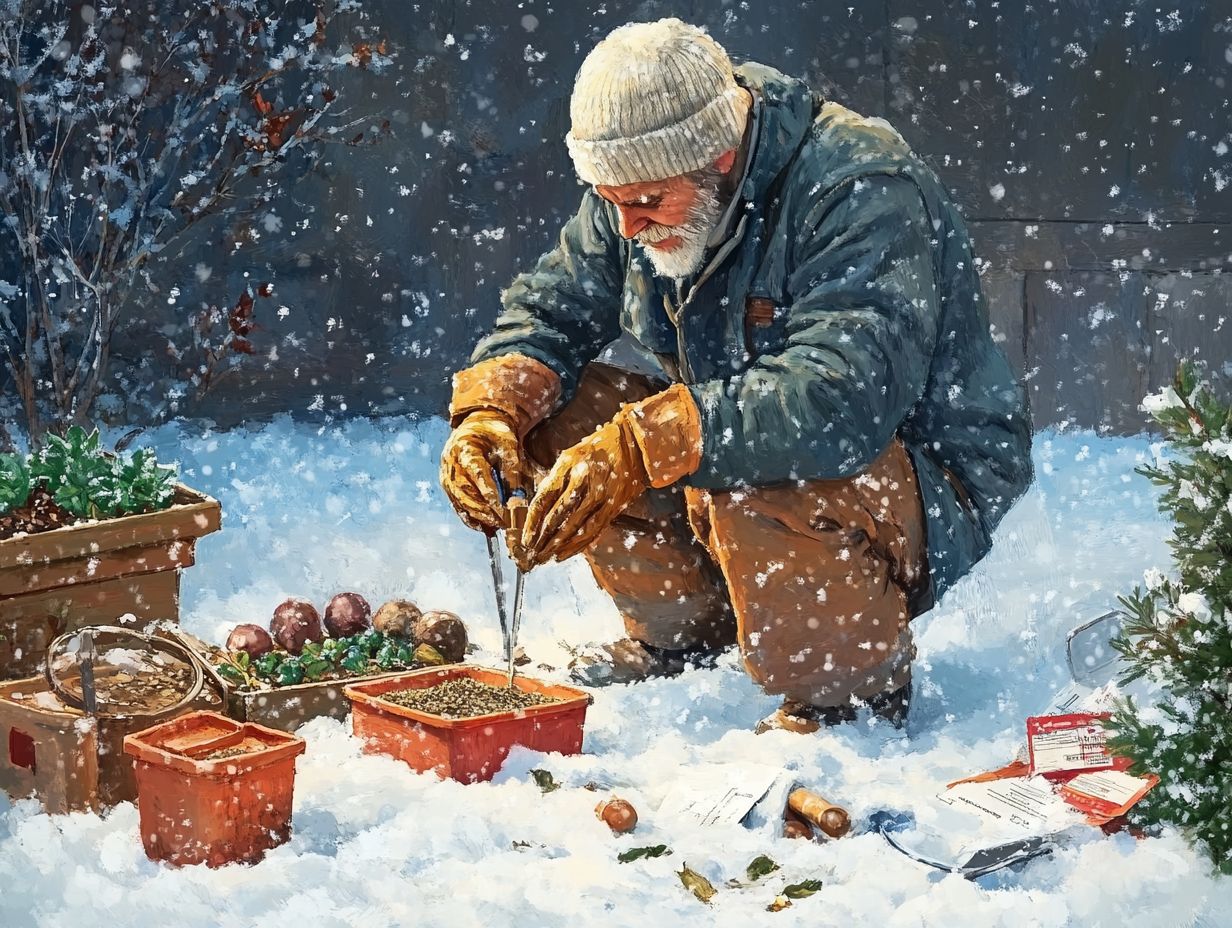
1. What is winter sowing and why is it beneficial for gardening?
Winter sowing is a gardening technique that involves sowing seeds in containers during the winter months and allowing them to naturally germinate in the spring. This technique is beneficial because it mimics the natural conditions that seeds would experience in the wild, resulting in stronger and more resilient plants.
2. What are the key factors to consider when choosing seeds for winter sowing?
When selecting seeds for winter sowing, choose cold-hardy, native or adapted plants that can withstand the harsh winter climate. It’s also essential to select seeds that require a period of cold temperatures, known as natural stratification, to germinate. For those interested in maximizing their yields, consider these tips for growing microgreens in winter.
3. How should I prepare my containers for winter sowing?
Use clear plastic containers with drainage holes for winter sowing. It is recommended to use containers with a larger surface area, such as milk jugs or plastic soda bottles, to allow for proper air circulation and root growth. For more tips, refer to these 5 winter gardening hacks for success. Before sowing, wash the containers with soap and water and sterilize them with a diluted bleach solution to prevent mold and disease.
4. Is it necessary to keep my winter sown containers outside during the entire winter?
Yes, keep your containers outside during winter. This allows the seeds to experience natural temperature changes and moisture levels.
However, protect them by placing containers in a sheltered area. This prevents them from becoming too wet or getting damaged by strong winds.
5. How do I know when to move my winter sown seedlings to their permanent location?
Your seedlings are ready for transplanting when the weather warms up and they have developed a strong root system. Look for signs like new growth or roots coming out of the drainage holes.
This usually happens in early spring, but it can vary based on your location and the type of plant.
6. Can I use winter sowing for all types of plants?
Winter sowing is effective for many plants, but not all. It’s important to research each plant’s specific needs, especially considering the top challenges of winter gardening before trying winter sowing.
Generally, choose plants that are hardy in your zone and need a natural cold period, known as stratification.


